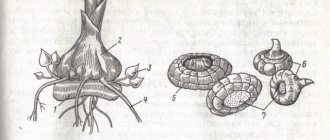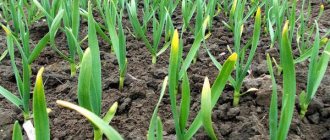Gladioli are magnificent flowers that delight every year with their solemn and majestic beauty. But many novice gardeners are convinced that updating them is only possible by purchasing new corms. Children of gladioli, as a rule, are either not taken into account at all, or it is considered that preserving and using them for subsequent planting is a very labor-intensive task.
What are gladiolus babies?
For many gardeners who have been growing gladioli for many years, it is not at all news that the lifespan of one corm is no more than 4-5 years, even with the most ideal care. Further, flowering becomes more sparse, uninvited diseases appear, the bulb begins to age and nothing can be done about it. You have to either buy bulbs of new varieties, or look for a favorite variety, or try to update it by growing new planting material from the baby. The last method is the most profitable in all respects, although it requires some effort.
After all, a gladiolus baby or tuber is nothing more than an organ of its vegetative propagation, like a cutting. It completely retains all the maternal properties of the variety, since it is a complete similarity to the mother bulb, only small in size. Children are formed at the base of an adult corm at the end of the growing season. Their number and size depend directly on the variety of gladiolus, on the duration of the growing season, on the age of the mother corm, as well as on the depth of its planting and growing conditions. Some varieties of gladioli produce several dozen baby tubers. And there are also corms that are literally covered by children after digging them up. Their number can reach up to 200.
The baby is always covered with a dry shell, which is designed to protect it from adverse effects during a long period of rest. In some varieties of gladiolus, this shell can be very dense, so much so that it can hardly be separated by hand.
Children are usually divided into two groups, according to their size:
- Category 1 (large) have sizes from 5 to 10 mm, and quite large and mature corms can ripen from them already in the first year after planting.
- 2nd category (small), ranging in size from 3 to 5 mm. Full-fledged flowers can be obtained from them only after 2 years of cultivation on average. Although a lot depends on both care and development conditions.
Reproduction of gladioli by children (tuber buds)
The most reliable, but at the same time simplest way to propagate a flower you like is to collect tubers from it. Garden gladioli of any variety produce them in sufficient quantities after the end of the flowering period.
What it is?
Corms form the basis of bulbous plant species; it is from them that the growth and development of the future flower begins. Depending on the variety, a different number of children are formed on the mother bulb.
Sometimes you have to resort to stimulating this process by cutting off the peduncle just before the end of flowering.
Propagation of gladioli by tuber buds allows you to quickly propagate your favorite variety, as well as rejuvenate your own plantings.
What are children for?
Since children are the main organ of vegetative propagation of gladioli, their main task can be considered the renewal and preservation of selected varieties. With the help of children, a collection of gladioli can be preserved for many decades, even though some of its representatives live no more than 5 years.
But this is not the only function of children. It has long been proven that, as in the case of other plants, growing new gladioli from children improves their adaptability to specific site conditions and increases resistance to various infections. Thus, when renewing planting material, it is simultaneously improved and its decorative properties are enhanced.
And finally, using gladioli babies for planting allows you to significantly increase the number of flowers grown in a relatively short time, which can be useful for exchanging or selling them.
Landing rules
Planting gladioli seedlings is no more difficult than vegetable seedlings. The whole process is greatly simplified by the fact that each plant “lives” in a separate pot. To plant it, it is enough to cut off the bottom of the container and bury it in the ground in this form.
Thanks to this, the roots will remain intact, there will be no mis-grading, and it will be easy to dig up the corms later. After planting, young plants must be covered with spunbond (agrofibre) to protect them from spring return frosts.
Did you know? In the Middle Ages, flour obtained from gladioli corms was used to make bread.
Gladioli are very beautiful flowers that can be grown on your site both to decorate your landscape space and for sale. The process of planting and caring for them is not complicated, which makes many gardeners very happy. Try growing at least one flower on your windowsill or garden bed, and you will become a fan of its beauty.
How to store babies in winter
To safely preserve the babies during the winter, they must first of all be separated from the mother’s bulb. Then they are washed under running water and laid out to dry in a dry and warm place out of direct sunlight. The drying time in such conditions should be at least a month. To make it easier to handle them in the spring, the babies are sorted by size before storing them. The rather large children of the first category are considered the most convenient for further work. Small children of gladioli of the second category are used only if it is necessary to obtain many new plants at once or the total number of children is not enough for certain purposes.
Comment! In addition to the size, gladioli babies also differ in the number of root tubercles. At the same time, it was noticed that even with the initially small size of the baby, it grows into a much more powerful flower if it has a larger number of tubercles.
The optimal conditions for preserving gladiolus babies until spring are a dry place with a temperature no higher than + 15 °C. If it is possible to maintain the temperature within the range of + 5 ° C to + 10 ° C with simultaneous low humidity in the room, then the children can be kept in such conditions for two years.
What to do after digging and how to store them?
Everyone knows that gladioli corms need to be dug up in the fall. The timing of digging depends on the region, but it is important that the bulbs are ripe. Typically, gardeners determine the period by counting the days from the completion of flowering of gladioli or cutting of flower stalks. On average - 30 days, for late varieties - up to 45-50 days. All tubers are separated from adult bulbs, carefully washed and then laid to dry.
ON A NOTE! When selecting children, try to sort all the specimens and put them in storage. This will allow you to obtain a large amount of planting material of all varieties of gladioli in the spring.
In winter, children are preserved very well, much better than adult bulbs. For them it is necessary to create an optimal mode:
- room with ventilation;
- temperature – from +3ºC to +8ºС.
The temperature at which children are stored should not exceed +15ºС. Every month it is necessary to inspect the children, removing damaged or dried tubers.
Preparing gladiolus babies for planting
Approximately two weeks before the expected date of planting the children in open ground, they must be prepared for this process.
Peeling
The first procedure, which is highly desirable for the rapid germination of children and their good development, is to cleanse them of covering scales. If it is not removed before planting, it can delay the germination of children for a significant period, up to a month or more. Moreover, it is believed that it is the peeled children of gladioli that are able to form a larger corm. For beginners, this procedure seems very complicated and time-consuming. There is the following cleaning technology that can facilitate the process.
The smallest babies, about 3-4 mm in diameter, are placed on a hard surface and, pressing them with a finger, perform circular movements. The effort applied should be average. Do not press too hard on the baby so as not to crush it and damage the growth bud. But even as a result of the applied movements, the scales should be quite easily separated from the surface of the tuber.
To further facilitate the task of cleaning the babies from the covering shell, they are usually pre-soaked for an hour in warm water or, even better, in a soda solution (1-2 teaspoons of soda per 1 liter of water).
Germination
The cleaned babies are wrapped in a damp cloth or napkin, heavily soaked in a solution of phytosporin or potassium permanganate, and left in this form in a warm and bright place for several days (up to two weeks). It is important that the children are not immersed in the solution with their heads, but are simply soaked in a humid environment with access to air. Otherwise, they run the risk of suffocation. Swelling of root cones can occur literally in the first day, and seedlings appear within 10-12 days.
Interestingly, if you place the moistened seedlings in the refrigerator, the germination time will increase, but the seedlings will be very strong and friendly.
What to do with gladioli tubers in spring. Pre-planting treatment
How to prepare gladioli bulbs for planting in spring? After inspection and rejection, flower tubers are soaked in disinfectant solutions.
An important stage of preplant preparation is disinfection in order to prevent the development of possible fungal infections. For these purposes, a 0.3% solution of Fundazol is used. With its help you can get rid of fungal spores, thrips, and mycoparasites. To prepare gladioli for planting after winter, you need to soak them for 30–50 minutes.
They can also be placed in a pink potassium permanganate solution for 1-2 hours. Instead of potassium permanganate, you can use Maxim or a strong solution of table salt. After processing, the tubers are thoroughly rinsed and dried. Wet gladioli cannot be kept in a closed container.
Attention! When damaged by thrips, treatment with garlic juice is highly effective.
100 g of garlic is diluted in 1 liter of water. Gladioli are placed in the solution for 2-3 hours. Soaking in garlic solution often delays flowering by 10 days.
It is recommended to use the following mixture as a growth and flowering stimulator:
- 0.2 g boric acid;
- 0.3 g vitriol;
- 0.1 g cobalt nitrate.
These elements are diluted in a liter of water. Soak gladioli in this solution overnight (10–12 hours). If you prepare them according to this recipe, you will be able to get large flowers and significantly increase the number of buds.
Sodium humate is used as a growth stimulant, which is recommended to prepare gladioli seedlings for planting (make a 0.2% solution). Soak the onions for 3 hours. You can take a ready-made Epin solution, add 2.5 ml to 5 liters of water. Gladioli can be kept in it for up to 10 hours.
When figuring out how to prepare gladioli for planting in the spring, many people find a recipe for soaking them in a solution of copper sulfate and potassium permanganate. With its help, you can disinfect the bulbs and prevent copper deficiency in plants. 1 g of potassium permanganate and 5 g of copper sulfate are diluted in a liter of water. Peeled tubers are soaked for an hour.
Children also need to be prepared for disembarkation. But the solutions for soaking them are made less concentrated.
How to grow seedlings from gladioli babies
Growing gladioli seedlings from children at home does not present any particular difficulties and occurs according to the usual scenario. There are only two features in this process that should be taken into account.
- First, each child must be planted in a separate container so that during subsequent planting the roots are subject to minimal impact. The containers are placed in a deep tray and the seedlings are watered from below.
- Secondly, before the babies sprout, the place can be warm or cool. But after the sprouts appear, the growing temperature should be maintained between + 5 °C and + 15 °C.
Attention! Children of gladioli bulbs are planted as seedlings in light soil to a depth of 1-2 cm.
After germination, gladioli sprouts also need good lighting for 10-12 hours a day. It is better to use energy-saving or fluorescent lamps for additional lighting. Planting gladioli seedlings in flower beds and beds in a timely manner does not present any particular difficulties, since each plant lives in its own pot.
Growing gladioli seedlings from seeds
Now in gardening stores you can buy not only bulbs, but also gladioli seeds. Although you can easily grow the seeds yourself. But to pollinate flowers, the help of wind and insects alone will not be enough; you will have to do the pollination yourself. But after the flowers fade, you can see the fruits. They are a membranous box with a cracked upper part.
Inside the box there are winged seeds, there are many of them - up to 250 pieces. The ripened seeds are flat, equally colored dark brown, about 2 mm in size. A distinctive feature of the seeds is that they do not require physiological rest, that is, they can be sown immediately after collection. And within a few weeks they will begin to germinate. Or you can sow them in March-April.
Before sowing, collected seeds are stored in a room with a high level of humidity, since when they dry out, the seeds lose their viability.
Special containers or boxes are allocated for sowing. To grow seedlings at home, prepare nutritious soil consisting of equal parts of turf soil, humus and river sand. Before sowing, germinate the seeds by soaking them in warm water for 3-5 days or in a solution of growth stimulants. Plant the germinated seeds in the prepared soil to a depth of no more than 1 cm at a distance of 2 cm from each other. Containers with sown seeds are placed on warm and sunny windowsills.
At
When growing baby gladioli from seeds, be prepared for the fact that their varietal characteristics may not be preserved.
In the fall, around September, small onions are dug up from flowers planted with seeds. They are carefully separated from the stem. The collected children are treated in a pink solution of manganese, then dried, placed in paper bags and stored at a temperature of +4+8ºС.
During the entire storage period, planting material is checked, promptly removing damaged specimens. Damp onions must be dried again and placed in another dry bag.
How to plant gladioli babies in beds
Gladioli babies are planted in open ground beds when the last frosts are coming to an end. In this case, the soil should have time to warm up at a depth of 8-10 cm to approximately + 10 °C. The soil for planting is prepared mainly in the fall, and in the spring it is further loosened and shallow grooves are created.
It is strictly not recommended to plant children in the same place with adult gladioli corms. They grow large in size and will certainly shade the seedlings of young plants. And the latter require good sunlight for good growth and development.
Therefore, it is better to set aside a separate small area for growing gladioli children.
The planting depth is determined by both the size of the children and the structure of the soil. It should also be understood that shallower planting will, of course, ensure faster germination, but will also require constant vigilant monitoring of soil moisture levels. If you plant gladioli babies at a shallow depth, there is a high probability of drying out, and in this case, seedlings may not appear at all. And the large planting depth guarantees slow but sure germination due to a constant level of humidity.
Usually they follow the traditional rule that the planting depth should be approximately equal to 3 bulb sizes. But on light soil it is better to increase the planting depth to 3-4 cm.
A distance of 5-7 cm is left between the children, with row spacing of 15-20 cm. Sometimes novice gardeners have difficulty determining where the roots of the child are and where the sprout is. In principle, this is not so important. In industrial floriculture, gladioli children can even be planted with their roots up. In the process of development, the sprout itself will determine the right direction and find its way to the light.
Advice! It is best to cover the children not with ordinary soil, but with loose humus, so that the crust that forms on the surface of the earth does not interfere with their germination.
If during the planting period there is still a possibility of frost, then it is better to protect future seedlings by covering them with film or non-woven material. The first shoots may appear within 12-18 days after planting.
Planting and caring for gladioli children in open ground
If you do not want to grow flowering gladioli from children in the same year, they can be planted in open ground at the same time as adult bulbs. But for this they need to allocate a separate flowerbed.
Many gardeners, especially beginners, believe that adult corms can be planted mixed with young planting material. This is completely wrong, and here's why. Adult specimens grow fairly wide leaves. And small children with thin sprouts will not have enough light, and nutrition too, and they will develop very poorly. And over the summer a small onion will grow and, of course, it will not bloom.
The soil for gladioli should be fertile and loose. The beds (flower beds) should be located in an open, sunny place. Furrows are made in the garden bed no more than 5 cm deep, the distance between them is 10 cm. A layer of rotted compost is poured onto the bottom. It is not recommended to use manure, as it can carry various diseases.
The onions are stuck into the bottom of the groove with the top up. The depth of embedding in the soil depends on their size. Remember, the depth should be equal to 2/3 of the size of the baby itself. If you plant shallowly, there will not be enough moisture in the upper layers of the soil, since the soil dries out faster at the top.
We fill the furrows again with a layer of rotted compost, and then water them generously.
Care consists of timely watering, fertilizing, weeding and loosening. As soon as the first shoots hatch, the plants need nitrogen fertilizers. Therefore, 2-3 weeks after planting, fertilize with nitrogen fertilizers: herbal infusion or urea solution. After a month of planting, you can water it with a solution of boric acid, it promotes the formation of a healthy and strong bulb.
Later, fertilizing with phosphorus-potassium fertilizers is carried out once every 10-14 days. Gladioli respond very well to ash fertilizers. Ash can be scattered between the rows, and then, when loosened, embedded in the soil. Or make an ash solution and water the plants at the roots. To prepare it, take 2 cups of sifted powder and pour boiling water over it. Leave to infuse for several hours until the solution cools completely. Then the working solution is diluted with water to a volume of 10 liters.
Caring for gladiolus babies
After the first shoots appear, it is necessary to water them abundantly, especially in dry weather. They also carefully loosen the row spacing so as not to damage the baby. In the future, watering is carried out regularly as the topmost layer of soil dries.
Children feed gladioli about 6 times throughout the season, leaving intervals of at least 10 days between procedures. The first fertilizing is carried out a month after emergence. For it, urea is used, diluting 10-15 g in 10 liters of water.
In the middle of the growing season, gladioli babies are fed with organic fertilizers obtained from an infusion of animal and bird droppings or herbs.
In the second half of summer, complex mineral fertilizer with microelements is usually used as fertilizing.
If at the end of the season flower shoots appear on the children, it is recommended to remove them so as not to weaken the plants. In this case, more nutrients will be deposited in the bulbs themselves and their full flowering will be ensured next year.
Gladioli bulbs formed from children are dug up, usually in September.
Planting and care
How to plant children
To plant in the beds, you need to wait until the ground warms up to +10°C. Planting is carried out shallowly, no more than 3 cm. This is necessary in order to improve the development of corms and accelerate germination. The children are laid out along the bottom of the furrow and sprinkled with sand. There is no need to water gladioli yet.
If children are planted that were germinated without cleaning, the depth should be 5-6 cm. The grooves are shed with water. The children are placed at the bottom of the furrow and covered with earth. You can plant individually, then there is a chance of getting large corms in one season.
When planting a large number of gladioli, experienced gardeners prefer dense planting, in which the furrow is made wide, and the children are placed in it in a wide strip. When planting, a distance of no more than 2 cm is left between the children of gladioli. A meter-long groove with such planting can accommodate up to 400 children.
Child care
At the time of planting and active growth, children need moist soil. They need to be moistened regularly. When the babies hatch and the first shoots appear, you need to protect the beds with non-woven material or film from possible cold snap. There is no need to worry too much, since gladioli usually tolerate slight drops in temperature well.
Plant feeding is carried out within 12-14 days after germination. Mullein solution is best, but any organic fertilizer can be used. The soil between the rows must be loosened regularly. It is necessary that the root system be provided with additional air supply. Fertilizers will help form large corms. Young bulbs do not tolerate drought very well, so it is necessary to ensure regular and constant watering throughout the season.
With good care and favorable conditions, large gladioli babies can bloom in the first year. But it is better to carefully break out the flower stalks. For what? To allow the corms to ripen more fully by the time of autumn digging. In the fall, from the small children you planted, you can get full-fledged corms, which are dug up before the first frost.











